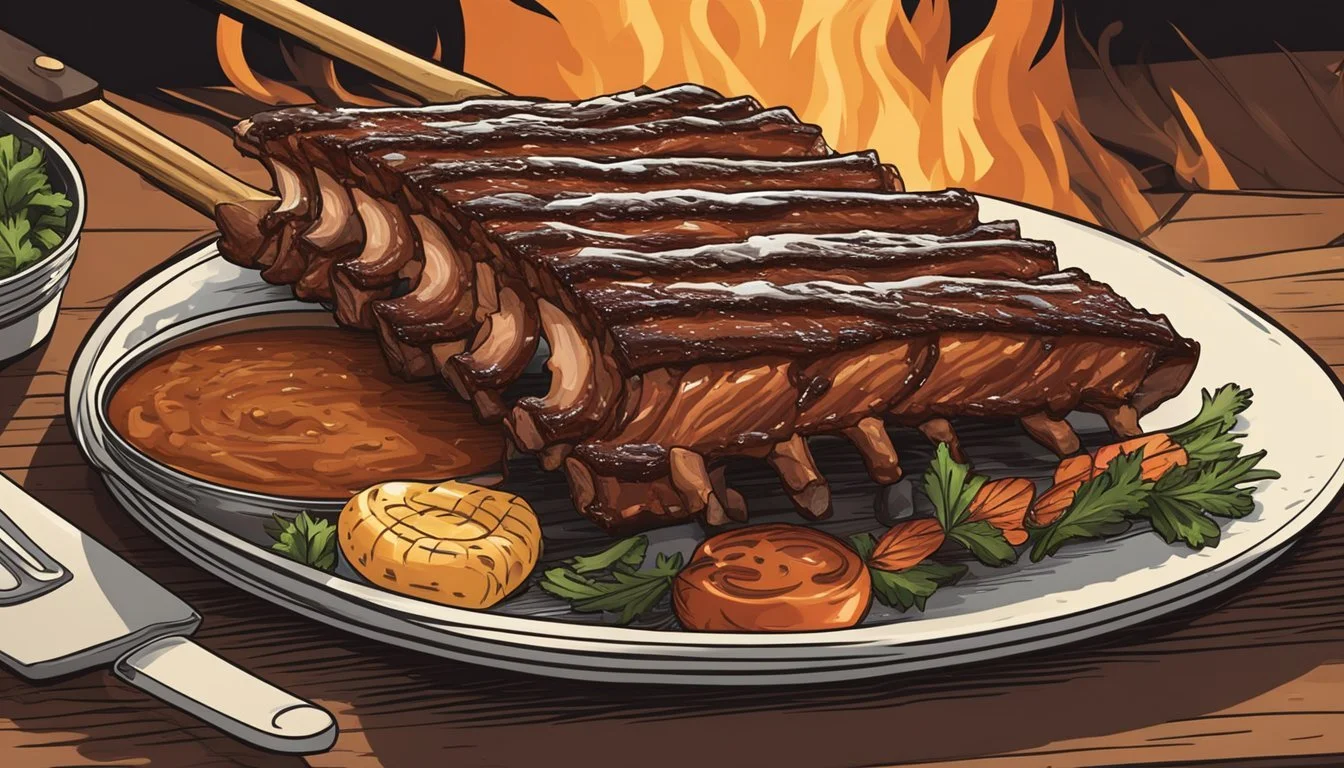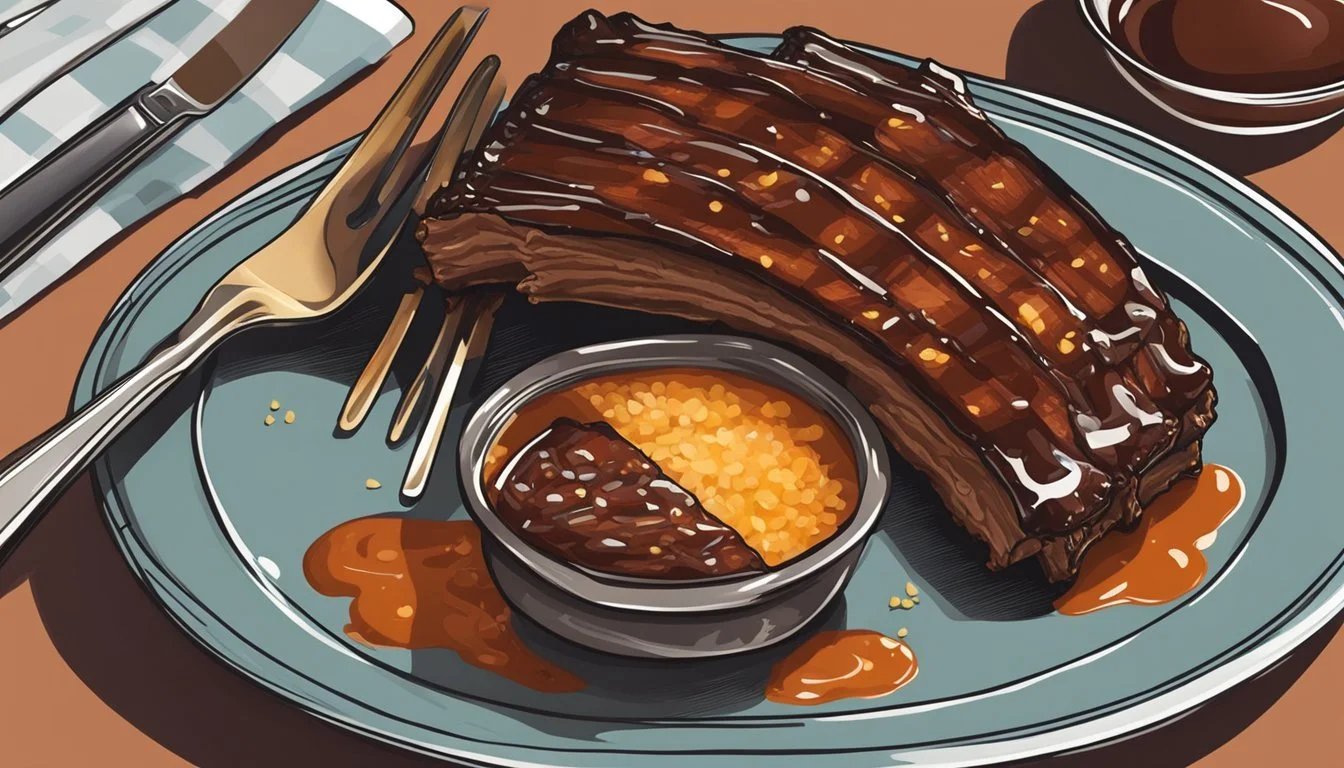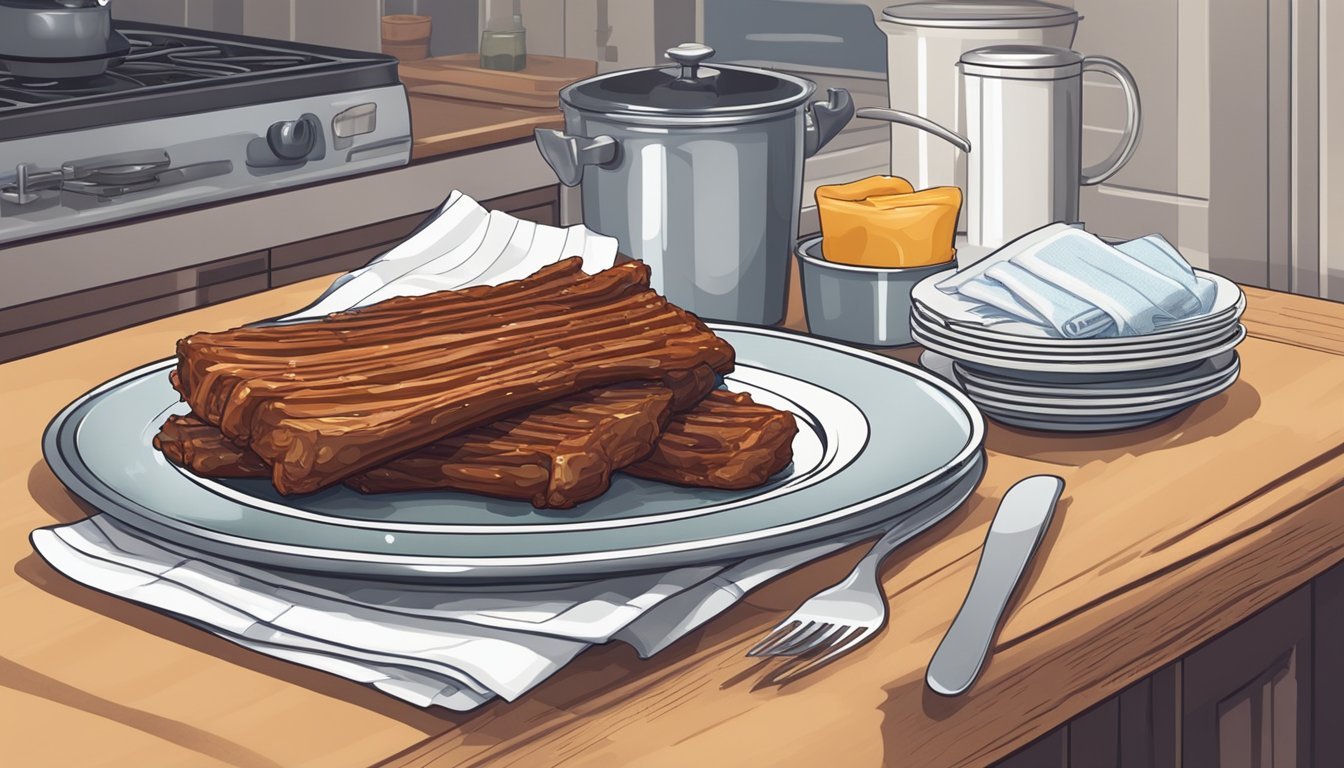How Do You Eat a Rack of Ribs?
A No-Nonsense Guide to Enjoying Barbecue
Eating a rack of ribs can be both a delicious and potentially messy affair. It requires technique and preparation to fully enjoy the experience. A rack of ribs, typically served as a hefty portion of meat, is often cooked until the meat is tender and flavorful. The process begins with the individual separation of ribs from the rack. Using a sharp knife or kitchen shears, one can cut between the bones, portioning the rack into single ribs ready for consumption.
The attire chosen for eating ribs is also practical, favoring clothes that are easily washable. This preemptively addresses the likelihood of stains given the nature of sauces and the hands-on approach needed for eating ribs. For further stain protection, diners might carry a detergent pen for any unexpected splashes onto their clothing. When actually eating the ribs, individuals typically pick up a single rib and eat along the bone from one end to the other, savoring the meat and seasonings used in preparation.
The shared nature of a rib feast, along with the tactile pleasure of eating with one's hands, contributes to the informal and communal atmosphere often associated with rib eating. Whether at a backyard barbecue (What wine goes well with barbecue?) or a dedicated rib joint, the approach remains consistent—enjoy the ribs with gusto and a touch of caution for personal tidiness.
Choosing the Right Type of Ribs
When embarking on the culinary experience of eating a rack of ribs, one must first select the proper type of ribs. The choice largely depends on personal preference and the desired outcome in terms of flavor and texture.
Identifying Different Rib Cuts
Baby Back Ribs: Also known as loin ribs, these come from the top of the ribcage between the spine and the spareribs, below the loin muscle. They are shorter, leaner, and are known for their tenderness.
Spareribs: Cut from the belly side of the ribcage, spareribs are flatter, meatier, and have more fat than baby back ribs, which contributes to their robust flavor.
St. Louis Style Ribs: These are spareribs that have been trimmed to a uniform rectangular shape, removing the brisket bone. It's a neat, flat rack that is easier to brown.
Country-Style Ribs: These are not ribs in the traditional sense, but are cut from the blade end of the loin close to the pork shoulder. They are meatier and are often cooked like a steak.
Selecting Quality Meat
When seeking quality meat for ribs, there are a few aspects to consider:
Marbling: Look for racks with good marbling, the white specks of fat within the meat that promise juiciness and flavor.
Color: Fresh pork ribs (What wine goes well with pork ribs?) should have a pinkish hue and the bones should be free from discoloration.
Smell: Fresh ribs should not have any off-putting smells.
Selecting the right type of ribs requires an understanding of the distinct features of each cut and a discerning eye for fresh, quality meat. Whether the preference leans towards the tender baby back ribs or the flavorful spareribs, proper selection is the first step to an enjoyable eating experience.
Preparation Basics
Before one begins to cook a rack of ribs, it is essential to properly prepare the meat to ensure it has the best flavor and texture. Preparation includes trimming excess fat, removing the membrane, and carefully applying seasoning and marinades.
Trimming Excess Fat
To start, one needs to trim any excess fat from the ribs. A small layer of fat can remain to maintain moisture and flavor during cooking, but thick layers should be removed. Excess fat not only affects cooking time but may also result in flare-ups or an unbalanced flavor profile.
Removing the Membrane
The membrane, or silverskin, located on the bone side of the rack, can prevent seasonings from penetrating the meat and may result in a tough texture. To remove it, one should gently slide a knife under the membrane at one end of the rack, lift, and then use a paper towel to grasp and pull the membrane away from the ribs. If the membrane tears, continue the process until it is fully removed.
Applying Seasoning and Marinades
Next, it's on to the seasonings and/or marinades. One should evenly coat the ribs with a combination of salt, sugar, and spices such as garlic powder, black pepper, paprika, and cumin. A generous amount of rub should be applied on all surfaces of the ribs to create a flavorful crust. If using a liquid marinade, it should properly coat the ribs, ensuring that the rack soaks up the full flavor. Whether opting for a dry rub or wet marinade, the seasoning should be given ample time to penetrate the meat before cooking.
Cooking Techniques
Preparing a perfect rack of ribs involves various cooking techniques, each contributing to the tenderness, juiciness, and flavor of the dish. Here are some of the most effective methods.
Grilling Over Charcoal or Gas
Charcoal grilling infuses ribs with a deep smoky flavor and creates a desirable charred texture. Begin by heating the charcoal grill to a medium temperature, then place the ribs meaty side down. Grill for about 5 minutes until they form a crust and then flip them. Cover the grill to maintain an even temperature and retain smoke for flavor.
Gas grilling requires a preheated grill on medium heat. It's cleaner and easier to control than charcoal and requires placing the ribs on an indirect heat zone. Wrap the ribs in aluminum foil with a bit of liquid, such as apple juice, to keep them moist.
Oven Roasting
Oven roasting is a convenient method for cooking ribs, especially if you seek a controlled cooking environment. Preheat the oven to around 275°F. Place the ribs on a baking sheet lined with aluminum foil and season them with your preferred spices. Encase the ribs in foil to create a seal that traps moisture, ensuring the ribs turn out tender.
Low and Slow Smoking
Smoking ribs in a smoker or indirectly on a grill adds a profound smokey dimension. Cook pork ribs at a low temperature around 250°F, typically using wood chips like hickory or mesquite for flavor. The smoker or covered grill should maintain a steady internal temperature, with the ribs cooked low and slow for hours until the connective tissue breaks down, ensuring a juicy texture.
Alternative Methods
Besides the traditional methods, there are alternate ways to attain tender ribs. Using a slow cooker can soften the fibers of the ribs over an extended cooking period. Before placing in the slow cooker, some recipes suggest boiling the ribs briefly to tenderize them. Although this method may not impart a smoky flavor, it is a set-it-and-forget-it approach that results in fall-off-the-bone ribs. Ribs can also be cooked under high heat for a short time in the oven if you prefer a quicker cooking method, but this may affect their juiciness and tenderness.
Enhancing Flavor
To elevate the taste experience of ribs, one must consider the use of sauces and glazes, as well as the method of basting. These elements work in harmony to ensure that every bite is infused with maximum flavor.
Choosing Sauces and Glazes
A well-chosen sauce or glaze can transform a rack of ribs from good to great. Barbecue sauces vary in sweetness, tanginess, and spice levels, allowing for customizable flavor profiles. Here are some popular sauce options:
Classic BBQ sauce: A balance of sweet, tang, and spice, typically incorporating ingredients like tomato sauce, vinegar, sugar, and various spices.
Honey glaze: Adds a sticky sweetness; best applied during the last minutes of cooking to avoid burning.
Spicy sauce: Infuses heat with ingredients like cayenne or hot peppers.
Worcestershire-based sauce: Offers a deep umami flavor.
When selecting a sauce, one should consider the desired end result—whether it's a sticky glaze that caramelizes on the surface or a wetter, vinegar-based sauce that soaks into the meat.
Basting Techniques
Basting ribs keeps them moist and infuses flavor as they cook. The techniques can vary, but here are a few key points:
Basting brush: Use this to regularly slather sauce onto the ribs, which creates layers of flavor.
Mop: A mop, or a basting mop, is a tool designed to spread large amounts of thinner sauces or mops over the meat. This technique works well for vinegar-based or thinner sauces.
Timing: Baste with thicker sauces or glazes closer to the end of cooking time to prevent burning. With thinner sauces, ribs can be basted earlier and more frequently.
Utilizing these flavors and techniques will ensure the ribs remain juicy and are packed with deliciousness in every bite.
Serving and Presentation
To maintain the integrity of their texture and flavor, ribs should be served correctly. This section focuses on the method of cutting and plating ribs for an optimal dining experience and suggests pairing with complementary sides.
Cutting and Plating
When one serves a rack of ribs, the goal is to preserve the tender meat and the crispness of the outer bark. One should start by placing the rack with the bone side facing up to identify the natural separations. Using a sharp knife, cut between the bones to create individual portions, ensuring each piece consists of meat and bone. After the ribs are sliced, they should be arranged on a serving dish in a visually appealing manner.
Pairing with Sides
A well-considered side dish can enhance the flavors of the ribs. Classic pairings often seen with ribs include:
Coleslaw: Its creamy texture and tangy flavor balance the savory notes of the ribs.
Beans: A staple at barbecues, beans offer a hearty complement to the main dish. For a more substantial meal, the ribs may also be served alongside carbs such as steak fries. Whatever the side, one should ensure it does not overshadow the ribs, which are the centerpiece of the meal.
Expert Tips and Tricks
When it comes to enjoying a rack of ribs to its full potential, chefs emphasize the importance of precise temperature control, tenderization methods, and finishing techniques to achieve that perfect balance of flavor and texture.
Temperature Monitoring
Keeping a vigilant eye on the internal temperature is critical for ribs that are cooked just right. Ribs are best cooked slowly, and an internal temperature of around 190-203°F (88-95°C) indicates they are done. It is advisable to use a meat thermometer for accuracy. This steady heat allows the collagen and fats to break down properly, enriching the juices that make the meat tender and delish.
Slow Cooking: Maintains low, even heat over several hours.
Steaming/Braising: Raises the internal temperature gently to keep the ribs moist.
Maximizing Tenderness
Achieving fork-tender ribs requires a combination of proper cooking methods and techniques to tenderize the meat. Chefs often incorporate a mixture of vinegar, salts, sugars, and spices into their rib preparations:
Vinegar: Breaks down tough proteins.
Salt: Enhances flavor and retains juices during cooking.
Using long, slow-cooking methods such as slow cooking, steaming, or braising further ensures that the ribs become succulent and fall off the bone.
Finishing with a Crisp Surface
To impart that irresistible final touch, ribs should be finished with a crisp surface. Whether on the grill or under the broiler, applying a high heat at the end of the cooking process can caramelize the outer layer, adding a delightful texture contrast. One can perform the toothpick test—if it slides in with little resistance, the ribs are likely ready for this last step.
Grilling/Broiling: Applied briefly to create a crisp surface.
Sauce Application: If used, it should be applied during the last few minutes to prevent burning.
Safety and Cleanup
When preparing and enjoying a rack of ribs, safety should be the priority, and appropriate measures for cleanup must be in place to ensure a hassle-free dining experience.
Cooking Safely
It's essential to handle ribs with care to prevent any food-borne illness. One should always use separate utensils and cutting boards for cooked and uncooked meat to avoid cross-contamination. When grilling, ensure that the ribs reach an internal temperature of 145°F before consuming. To preserve leftovers safely, wrap them in aluminum foil or plastic wrap and store them in the refrigerator within two hours of cooking.
Proper Disposal of Waste
After enjoying a rack of ribs, promptly dispose of any waste to maintain cleanliness. Used aluminum foil that contained the ribs should be cool to the touch before it's crumpled and placed in a recycling bin, if accepted by the local recycling program. Any bones or scraps should be discarded in a sealed bag to prevent odors and avoid attracting any pests.
Summary
Eating a rack of ribs can be a delightful, albeit messy, culinary experience. It is advisable to start by dressing appropriately in clothes that are wash-friendly. This approach can help mitigate concerns about potential stains.
When ready to eat, one should separate the ribs. This is often done by using a sharp knife or kitchen shears to slice between the rib bones. The process involves flipping the rack to have the bone side facing up and cutting through the connective tissues between the ribs.
Once individual ribs are separated, it is customary to pick up a rib with one's hands and eat the meat from one end to the other. This hands-on method is part of the joy of rib consumption, as precision is set aside in favor of a more primal and engaging eating style.
For cleanliness during this process, diners should consider having accessories like napkins or wet wipes on hand. A detergent pen for on-the-spot treatment of any stains can also be a worthwhile addition to one's dining toolkit.
To summarize the practical steps:
Prepare: Wear suitable clothing and have cleaning items nearby.
Separate: Cut individual ribs from the rack.
Eat: Use hands to consume the meat directly off the bones.
Rib dining is considered a casual affair, and its associated etiquette reflects the hearty nature of the dish.







